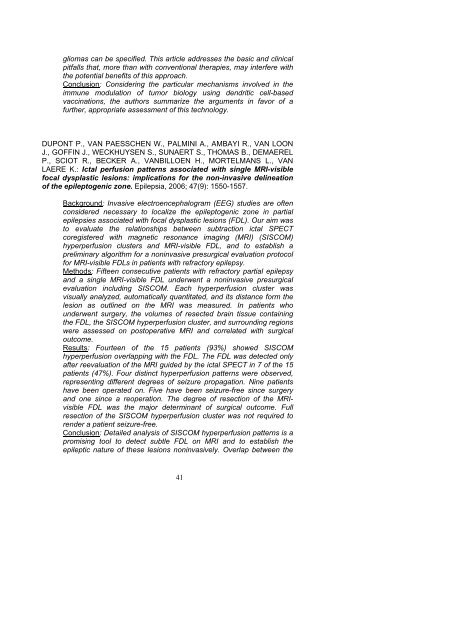2006 - UZ Leuven
2006 - UZ Leuven
2006 - UZ Leuven
You also want an ePaper? Increase the reach of your titles
YUMPU automatically turns print PDFs into web optimized ePapers that Google loves.
gliomas can be specified. This article addresses the basic and clinicalpitfalls that, more than with conventional therapies, may interfere withthe potential benefits of this approach.Conclusion: Considering the particular mechanisms involved in theimmune modulation of tumor biology using dendritic cell-basedvaccinations, the authors summarize the arguments in favor of afurther, appropriate assessment of this technology.DUPONT P., VAN PAESSCHEN W., PALMINI A., AMBAYI R., VAN LOONJ., GOFFIN J., WECKHUYSEN S., SUNAERT S., THOMAS B., DEMAERELP., SCIOT R., BECKER A., VANBILLOEN H., MORTELMANS L., VANLAERE K.: Ictal perfusion patterns associated with single MRI-visiblefocal dysplastic lesions: implications for the non-invasive delineationof the epileptogenic zone. Epilepsia, <strong>2006</strong>; 47(9): 1550-1557.Background: Invasive electroencephalogram (EEG) studies are oftenconsidered necessary to localize the epileptogenic zone in partialepilepsies associated with focal dysplastic lesions (FDL). Our aim wasto evaluate the relationships between subtraction ictal SPECTcoregistered with magnetic resonance imaging (MRI) (SISCOM)hyperperfusion clusters and MRI-visible FDL, and to establish apreliminary algorithm for a noninvasive presurgical evaluation protocolfor MRI-visible FDLs in patients with refractory epilepsy.Methods: Fifteen consecutive patients with refractory partial epilepsyand a single MRI-visible FDL underwent a noninvasive presurgicalevaluation including SISCOM. Each hyperperfusion cluster wasvisually analyzed, automatically quantitated, and its distance form thelesion as outlined on the MRI was measured. In patients whounderwent surgery, the volumes of resected brain tissue containingthe FDL, the SISCOM hyperperfusion cluster, and surrounding regionswere assessed on postoperative MRI and correlated with surgicaloutcome.Results: Fourteen of the 15 patients (93%) showed SISCOMhyperperfusion overlapping with the FDL. The FDL was detected onlyafter reevaluation of the MRI guided by the ictal SPECT in 7 of the 15patients (47%). Four distinct hyperperfusion patterns were observed,representing different degrees of seizure propagation. Nine patientshave been operated on. Five have been seizure-free since surgeryand one since a reoperation. The degree of resection of the MRIvisibleFDL was the major determinant of surgical outcome. Fullresection of the SISCOM hyperperfusion cluster was not required torender a patient seizure-free.Conclusion: Detailed analysis of SISCOM hyperperfusion patterns is apromising tool to detect subtle FDL on MRI and to establish theepileptic nature of these lesions noninvasively. Overlap between the41

















